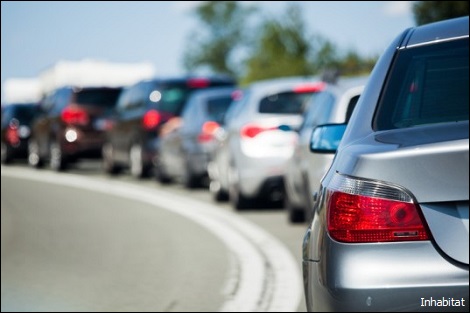
|
|

|
|
| April 25, 2024 |
|
Trump moves to roll back pollution standards for cars 
Setting up a potential conflict with California officials over air pollution and climate change, President Donald Trump started the process Wednesday of rolling back rules designed to limit emissions of carbon dioxide and other greenhouse gases from automobiles.
Already at odds with California leaders over immigration and other issues, Trump said his administration would launch a formal review of greenhouse gas standards that were launched in California and then imposed nationwide by former President Barack Obama. Automakers had complained to Trump that the regulations were too costly, and the president signaled that the review would result in less stringent standards. “We are going to ensure that any regulations we have protect and defend your jobs, your factories, we’re going to be fair,” Trump told autoworkers at a rally in Ypsilanti, Mich. He didn’t mention California or its role in initiating the greenhouse gas rules. Trump’s move won’t necessarily trigger a showdown with California. Trump apparently is backing down from a previous threat, raised by Environmental Protection Agency Administrator Scott Pruitt, that the administration would revoke California’s right to impose its own tougher standards on greenhouse gas emissions. That means California, and a dozen states that have the authority to follow California’s lead, could chart a separate course from the rest of the country. Still, it’s clear that conflict is a strong possibility. Anticipating Trump’s move, the state intervened in a lawsuit filed this week by automakers over the greenhouse gas standards. The state argued in court papers that “any weakening or delay of the national standards will result in increased harms to our natural resources, our economy, and our people.” Gov. Jerry Brown blasted the president’s decision in a letter to the EPA, calling it “an unconscionable gift to polluters.” Deborah Sivas, an environmental law professor at Stanford University, said litigation is almost inevitable. “This is going to be in the courts,” she said. “There’s no way California’s going to roll over on this.” Roland Hwang, director of energy and transportation at the Natural Resources Defense Council, said Brown and Mary Nichols, the chairwoman of the California Air Resources Board, will be influential in determining the outcome of the controversy. “California’s a key player here, no doubt about it,” Hwang said. “The pathway to weakening the standards, that path goes through California.” Nichols has suggested that CARB is willing to go along with tweaks to the greenhouse-gas standards, but not wholesale revisions. “We are willing to explore small changes but not big changes,” said CARB board member Daniel Sperling, a UC Davis transportation studies professor. California took the lead on cars and climate change in 2002, when former Gov. Gray Davis signed AB 1493, by then-Assemblywoman Fran Pavley, which called for a significant decrease in carbon dioxide emissions. The law survived a legal challenge by the auto industry. But the rules couldn’t take effect until the U.S. government granted California a waiver under the federal Clean Air Act to impose standards that exceeded national standards. Former President George W. Bush refused to grant the waiver, the only time that’s happened since the Clean Air Act was passed in 1970. Obama reversed course shortly after taking office during a carefully negotiated settlement with the auto industry, and the California rules became the law of the land. California had been granted scores of clean air waivers in the past, which typically forced carmakers to install various technologies on cars sold in California to reduce smog-forming particles and other pollutants. But carbon dioxide and other greenhouse gases are different; Sivas said the only practical way to reduce those emissions is by ramping up fuel mileage standards. Under the settlement announced by Obama in 2009, the mileage standards were raised gradually during the early years, she said. But between now and 2025, average fuel mileage is supposed to increase from 36 miles per gallon to 54 mpg. “It’s like a hill, it’s going to keep getting steeper,” said Karl Brauer, an auto industry analyst with Kelley Blue Book. The rules are already locked in for the model years 2017 through 2022; Trump’s action reexamines the rules for 2022 through 2025. If California continues to impose standards that exceed the nation’s, Sivas and Hwang said automakers wouldn’t have to make two sets of cars to comply with each set of regulations. Rather, they’d be forced in effect to dramatically change the mix of cars they sell in different states in order to achieve the fuel-mileage results that would produce the compliance with the greenhouse-gas rules. Carmakers would have to sell a lot more high-mileage vehicles in California than in states that adhere to the national standards. (Source: The Sacramento Bee) Story Date: March 17, 2017
|